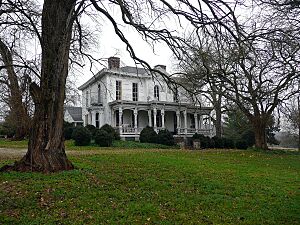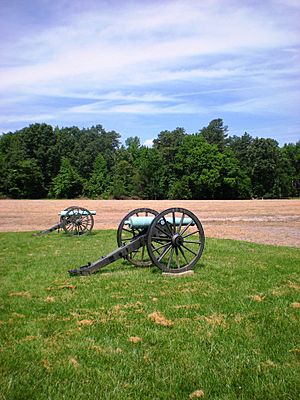Richard S. Ewell facts for kids
Quick facts for kids
Richard Stoddert Ewell
|
|
|---|---|
 |
|
| Nickname(s) | Old Bald Head Baldy |
| Born | February 8, 1817 Georgetown, D.C., U.S. |
| Died | January 25, 1872 (aged 54) Spring Hill, Tennessee, U.S. |
| Place of burial |
Old City Cemetery, Nashville, Tennessee
|
| Allegiance | |
| Service/ |
|
| Years of service | 1840–1861 (USA) 1861–1865 (CSA) |
| Rank | Lieutenant General (CSA) |
| Commands held | Second Corps, Army of Northern Virginia |
| Battles/wars | |
| Relations | Benjamin S. Ewell (brother) Benjamin Stoddert (grandfather) |
Richard Stoddert Ewell (February 8, 1817 – January 25, 1872) was an American military officer. He became a Confederate general during the American Civil War. He was a key commander under famous generals like Stonewall Jackson and Robert E. Lee. Ewell fought bravely in many battles. However, some of his actions at the Battle of Gettysburg and the Battle of Spotsylvania Court House later caused debate.
Contents
Early Life and Military Career
Richard S. Ewell was born in Georgetown, Washington, D.C.. He grew up in Prince William County, Virginia, from age three. He graduated from the United States Military Academy in 1840. He was known as "Old Bald Head" or "Baldy" by his friends.
Ewell joined the 1st U.S. Dragoons as a second lieutenant. He served on escort duty along the Santa Fe and Oregon Trails. During the Mexican–American War, he showed great courage. He was promoted to captain for his actions at the Battle of Contreras and the Battle of Churubusco. He even did a nighttime scouting mission with Robert E. Lee, who would later be his commander.
After the Mexican-American War, Ewell explored the New Mexico Territory. He was hurt in a fight with Apaches in 1859. In 1860, he became ill and had to return to Virginia to recover. He often faced health problems and injuries throughout his military career.
The Civil War Begins
As the United States moved closer to war, Ewell generally supported keeping the country together. But when his home state of Virginia left the Union, Ewell resigned from the U.S. Army in May 1861. He joined the Provisional Army of Virginia. He was made a colonel of cavalry. He was one of the first officers to be wounded in the war during a small fight at Fairfax Court House.
Ewell was promoted to brigadier general in the Confederate States Army in June. He led a brigade at the First Battle of Bull Run (First Manassas). His unit was guarding river crossings and did not get into the main fight.
After the battle, Ewell suggested to Confederate President Jefferson Davis that the Confederacy should free enslaved people. He believed they should join the army to help win the war. He was even willing to lead African American soldiers. However, President Davis did not agree with this idea. Like a few other Confederate generals, Ewell believed the Confederacy needed all the soldiers it could get, regardless of race.
A Unique General
Ewell was known for his unique personality. He was not very tall, about 5 feet 8 inches. He had a mostly bald, round head with a small amount of brown hair. His eyes were bright and seemed to bulge out. He also had a noticeable nose. Many people thought he looked like a bird, especially when he tilted his head. He spoke with a high-pitched lisp and sometimes muttered strange comments. He was also known for using strong language.
He was very nervous and restless. He often slept curled around a camp stool. He thought he had a strange "disease" inside him. Because of this, he mostly ate a simple dish called frumenty, which was wheat boiled in milk with sugar. People described him as a mix of unusual traits. He was one of the most eccentric generals in the Army of Northern Virginia. His soldiers admired his bravery and kindness, and they loved him even more for his quirks.
Fighting with Stonewall Jackson
In January 1862, Ewell was promoted to major general. He was given command of a division. In May, he was sent to the Shenandoah Valley to join "Stonewall" Jackson's army. Ewell and Jackson worked well together, even though they were very different. Jackson was serious and religious, while Ewell was witty and used strong language. Jackson was flexible in battle, but Ewell needed clear orders to fight effectively. Ewell eventually got used to Jackson's style of keeping his plans secret from his officers.
Ewell led his division very well during Jackson's Valley Campaign. He helped win several battles against larger U.S. armies. These victories included the Battle of Front Royal, the First Battle of Winchester, the Battle of Cross Keys, and the Battle of Port Republic.
After these successes, Jackson's army, including Ewell's division, was called to Richmond. They joined Robert E. Lee to defend the city against Maj. Gen. George B. McClellan's Army of the Potomac. Ewell fought notably at the Battle of Gaines' Mill and saw some action at Malvern Hill.
After Lee pushed back the U.S. army in the Seven Days Battles, another U.S. army under Maj. Gen. John Pope threatened from the north. Jackson was sent to stop him. Ewell defeated General Banks again at the Battle of Cedar Mountain on August 9. He then led his division into battle at Brawner's Farm on August 28, near the old Manassas battlefield.
During this battle, a bullet hit Ewell's left leg, shattering it. He lay wounded for hours before being found. His leg had to be amputated. He faced a long and painful recovery. He got a wooden leg, but it was hard to fit because of his injury. He even fell and hurt his leg again on Christmas Day.
While recovering, Ewell was cared for by his cousin, Lizinka Campbell Brown. She was a wealthy widow. Ewell had liked Lizinka since he was a teenager. They had flirted before, but now being close led to them getting married in May 1863.
Ewell returned to Lee's Army of Northern Virginia after the Battle of Chancellorsville. Stonewall Jackson had been mortally wounded in that battle. On May 23, Ewell was promoted to lieutenant general. He took command of the Second Corps, which was Jackson's old corps. This made him the third-highest-ranking general in the Army of Northern Virginia, after Lee and James Longstreet.
Later Battles and Capture
Ewell led his corps in the May 1864 Battle of the Wilderness. He fought well there. However, at the Battle of Spotsylvania Court House, Lee felt he had to personally lead the defense of a key area called the "Mule Shoe." This was because Ewell seemed unsure and inactive. At one point, Ewell became very upset and shouted at some of his retreating soldiers, hitting them with his sword. Lee had to calm him down, telling him he needed to control himself.
Lee felt that Ewell was not in good enough shape for field command anymore. So, he reassigned Ewell to defend Richmond. In April 1865, as Ewell and his troops were retreating from Richmond, many fires started in the city. A large part of the city, including the business district, was destroyed. Ewell and his troops were then surrounded and captured at Sailor's Creek. This happened just a few days before Lee surrendered at Appomattox Court House. Ewell was held as a prisoner of war at Fort Warren in Boston Harbor until July.
While in prison, Ewell and sixteen other former generals wrote a letter to Ulysses S. Grant. They expressed their shock and anger about the assassination of Abraham Lincoln. They wanted to make it clear that no one in the South supported such a crime.
Life After the War

After being released from prison, Ewell became a farmer. He worked on his wife's farm near Spring Hill, Tennessee, and made it successful. He also leased a profitable cotton plantation in Mississippi. His leg injury had mostly healed and no longer bothered him much. However, he still suffered from nerve pain and other health issues. He loved his wife's children and grandchildren very much.
Ewell was involved in his community. He was president of the board for the Columbia Female Academy. He was also a member of St. Peter's Episcopal Church in Columbia. He led the Maury County Agricultural Society.
In January 1872, Ewell and his wife both got pneumonia. They died within a few days of each other. They were buried in Old City Cemetery in Nashville, Tennessee. Ewell's book, The Making of a Soldier, was published after his death in 1935.
In Popular Culture
Richard Ewell has been shown in movies.
- Tim Scott played Ewell in the 1993 film Gettysburg. In the movie, another general tells Robert E. Lee that Ewell's decision not to take Cemetery Hill gave the U.S. army a big advantage.
- Ewell is the main character in the 1963 film Red Runs the River. In this movie, he is played by Bob Jones Jr.. The film shows Ewell's relationship with Stonewall Jackson and his religious conversion after his injury at the Second Battle of Bull Run.
See also


